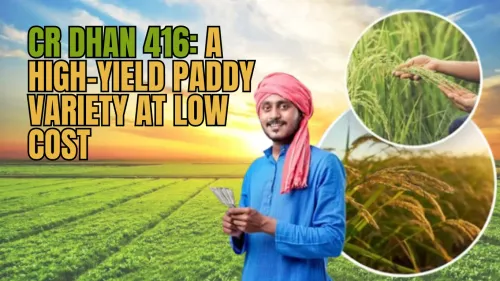CR Dhan 416: A High-Yield Paddy Variety at Low Cost

0 Views
Updated On:
CR Dhan 416 is a high-yield, pest-resistant paddy variety offering better production at lower costs, ideal for coastal climates.

Key Highlights
- High yield potential of 48.97 quintals per hectare
- Resistant to pests and multiple diseases
- Matures in 125 to 130 days
- Suitable for coastal climates like West Bengal, Maharashtra, Gujarat
- Developed by ICAR-National Rice Research Institute, Odisha
In today's climate change scenario, agricultural scientists are constantly developing crop varieties that can deliver better agriculture yields even in challenging weather conditions. One such breakthrough is the CR Dhan 416 variety of paddy. Developed by the ICAR-National Rice Research Institute in Cuttack, Odisha, this paddy variety is gaining attention for its resilience to pests, disease, and its ability to provide better yields at a reduced cost. Let’s explore the features and benefits of CR Dhan 416 and other high-yielding paddy varieties.
Specialty and Benefits of CR Dhan 416
The CR Dhan 416 variety has many features that make it ideal for modern-day cultivation. It can adapt to various climatic conditions, particularly in coastal regions like West Bengal, Maharashtra, and Gujarat.
Below are the key highlights:
- Climate Adaptability: Suitable for coastal areas, CR Dhan 416 can withstand challenging weather conditions, making it perfect for areas frequently exposed to moisture and storms.
- Fast Maturity: This paddy variety matures within 125 to 130 days, ensuring faster harvests.
- Pest and Disease Resistance: CR Dhan 416 is moderately resistant to several diseases, including brown spot, neck blast, sheath rot, rice tungro, and glume discoloration. It also provides resistance against pests such as brown plant hoppers, locusts, and stem borers.
- High Yield Potential: With an average production capacity of 48.97 quintals per hectare, this variety is perfect for farmers aiming for higher outputs with reduced costs.
- Climate-Friendly: Released as part of Prime Minister Narendra Modi's initiative, CR Dhan 416 is one of 109 climate-friendly crop varieties developed to withstand environmental stressors.
Other High-Yield Paddy Varieties
Several other paddy varieties can also provide high yields at lower costs. These varieties are well-suited for different climatic zones, offering farmers more options for cultivation.
Below are some notable examples:
- Pusa 1401 Basmati Paddy
- Developed by ICAR and the Indian Agricultural Research Institute (IARI), this semi-dwarf variety matures in 135 to 140 days.
- Yields around 4-5 tonnes per hectare.
- Known for its long, fragrant grains, this variety is tolerant to bacterial leaf blight and salinity.
- Pant Paddy-12
- Developed by ICAR and GB Pant University, this semi-dwarf variety matures in 110 to 115 days.
- Suitable for irrigated areas in North India, it offers yields of 7 to 8 tonnes per hectare.
- Pusa 834 Basmati Paddy
- This semi-dwarf variety matures in 125 to 130 days and can grow in low-quality soils with water shortages.
- With a yield potential of 6 to 7 tonnes per hectare, it is resistant to leaf blight and salinity.
- PHB 17 Variety
- Developed by the International Rice Research Institute (IRRI), this semi-dwarf variety ripens in 105 to 110 days.
- Produces yields of 6 to 7 tonnes per hectare and is resistant to leaf blast disease.
- Found suitable for irrigated areas of South and South East Asia, this variety tolerates diseases like bacterial leaf blight and tungro virus.
Also Read: 50% Subsidy for Solar-Powered Cold Storage for Farmers in Bihar
CMV360 Says
CR Dhan 416 and the other paddy varieties mentioned offer farmers viable options to improve their yields while reducing costs. With their resistance to pests, diseases, and climate adaptability, these varieties are paving the way for more sustainable and profitable rice farming.
